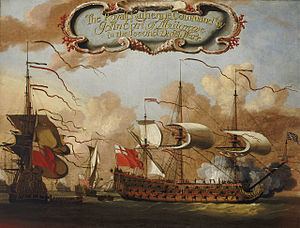Name HMS Royal Katherine Laid down May 1662 Renamed HMS Ramillies, 1706 Launched 26 October 1664 | Ordered October 1661 Commissioned 13 March 1665 Construction started May 1662 | |
 | ||
Fate Wrecked, 15 February 1760 | ||
HMS Royal Katherine (HMS Ramilles after 1706) was an 84-gun second-rate ship of the line of the Royal Navy, launched in 1664 at Woolwich Dockyard. Her launching was conducted by Charles II and attended by Samuel Pepys. Royal Katherine fought in the Second and Third Anglo-Dutch Wars and the War of the Grand Alliance before entering the dockyard at Portsmouth for rebuilding in 1702. She was upgraded to carry 90 guns and served in the War of the Spanish Succession during which she was renamed Ramillies in honour of John Churchill's victory at the Battle of Ramillies. She was rebuilt again in 1742–3 before serving as the flagship of the ill-fated Admiral John Byng in the Seven Years' War. Ramillies was wrecked at Bolt Tail near Hope Cove on 15 February 1760.
Contents
Launch
Royal Katherine was launched in 1664 by Charles II, an event attended by naval administrator Samuel Pepys. Pepys recorded the occasion in his diary and it was dramatised by BBC Radio 4 in 2012 as part of series 5 of The Diary of Samuel Pepys.
Anglo-Dutch wars
Royal Katherine participated in the Second Anglo-Dutch War fighting in the Battle of Lowestoft on 13 June 1665, the Four Days' Battle from 11 June to 14 June 1666 and the St. James's Day Battle on 4 August 1666. She was scuttled in June 1667 to prevent her capture by the Dutch during the Raid on the Medway.
Refloated, Royal Katherine fought again during the Third Anglo-Dutch War of 1672–4. She was captured by the Dutch during the Battle of Solebay on 7 June 1672 but was retaken the same day. Royal Katherine was also part of the Anglo-French fleet for the Battle of Schooneveld. She saw action in the War of the Grand Alliance, fighting at the Battle of Barfleur on 29 May 1692.
Rebuilds
Royal Katherine was rebuilt at Portsmouth in 1702 and became a 90-gun second rate. She served as the flagship of Admiral George Rooke in the War of the Spanish Succession from 1701. In 1706 she was renamed Ramillies in honour of John Churchill's victory at the Battle of Ramillies fought that year. Ramillies was rebuilt again at Portsmouth Dockyard between 30 November 1742 and 8 February 1743. She remained a 90-gun second rate in accordance with 1741 proposals of the 1719 Establishment, relaunching on 8 February.
She saw service in the Seven Years' War and was the flagship of Admiral John Byng when he failed to relieve Port Mahon and so lost the island of Minorca to the French. Byng was later controversially executed for this action.
Wreck
Ramillies was wrecked at Bolt Tail near Hope Cove on 15 February 1760. The ship's master had mistaken their location as Ramillies approached the Devon shore, and the vessel was already within Hope Bay when the error was identified. There was a strong onshore wind and Ramillies' captain ordered the anchors lowered to hold the vessel fast until it could turn back to open sea, but no purchase could be found on the sandy seabed and the ship continued to drift towards the coast. After several hours she struck the cliffs beneath Bolt Tail and sank; twenty-six seamen and one midshipman survived from her crew of 850 men. The sinking became the subject of a popular contemporary folk song, "The Loss of the Ramillies", a version of which has been recorded by the English folk band Brass Monkey.
